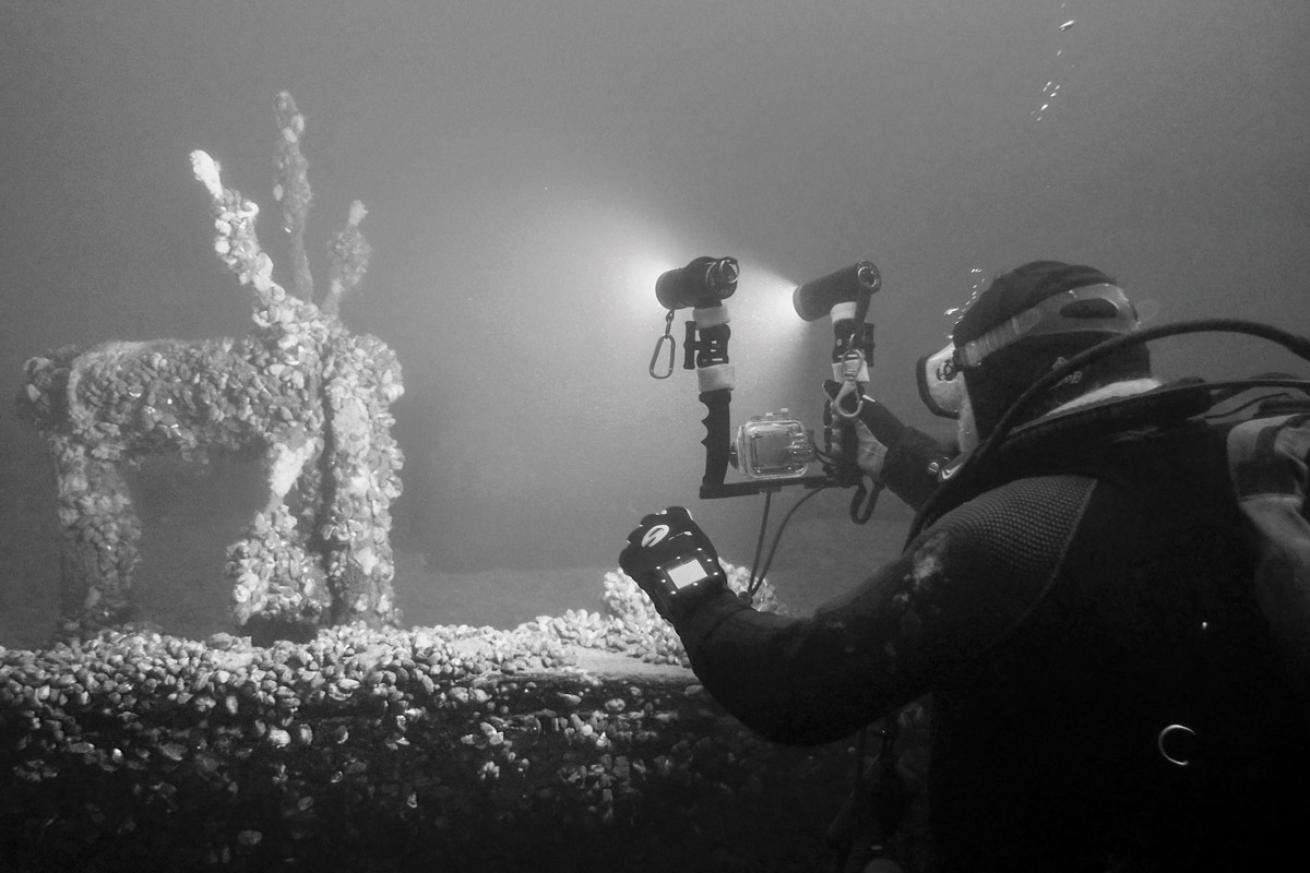Exploring the Wooden Wrecks in Lake Champlain

Shutterstock.com/stevelamondaA picturesque destination during the fall when the leaves change colors, Lake Champlain is also a great dive destination
"It’s a journey into the past.”
Joe Foroughi is a chemist and underwater photographer who dives almost every weekend, and one of his favorite backyard dives lies under a freshwater lake formed nearly 10,000 years ago.
Reaching depths more than 400 feet, Lake Champlain is home to the stuff of legend. It’s even said to be inhabited by a mythological creature named Champ—perhaps inspired by a real-life underwater fossil reef estimated to be more than 400 million years old.
In more recent history, the 455 square miles of lake straddling the border of New York and Vermont have become the final resting place for countless wrecked wooden vessels. Divers like Foroughi get a literal glimpse into the heyday of commercial shipping via these well-preserved shipwrecks.
Related Reading: How This Award-winning Underwater Photographer Got His Start by Volunteering

JOE FOROUGHIA diver takes a photo of the wooden ship’s wheel near the stern of the O.J. Walker. The well-preserved wreck is 86 feet long and rests at a depth of about 65 feet.
“There’s a lot of rewarding diving to be done in Vermont,” Foroughi says. The state’s variety of offerings includes clear mountain lakes, quarries, cave diving and wreck diving.
“There’s a gold mine of all these awesome wrecks,” adds Ken Morris, a diver always on the lookout for new skiing, spelunking and scuba diving sites when visiting his friend’s cabin near Manchester Vermont. “My buddy and I had the opportunity to dive a few small wrecks in the lake. The O.J. Walker was the best, with its large schools of fish and ominous aura. These dives were not too deep, so bottom times were plentiful.”
The O.J. Walker was carrying a cargo load of building materials in May 1895 when it sank in a storm offshore Burlington, Vermont. The wreck sits in about 65 feet of water and is accessible to open-water divers that are comfortable in cold water. Drysuits are preferred when diving the wreck during most of the year. Water temperatures reach the mid-60s in late summer. When planning your visit, check the University of Vermont fall parents’ weekend schedule—Morris cautions that lodging can be hard to come by if your trip overlaps with those dates.
Having explored the O.J. Walker about a half dozen times, Foroughi recounts the intricate setting that keeps him coming back with his camera: “Masts have fallen over—one is lying across the wreck and extends into the mud. The wheel is still partially intact. The rudder is still intact. The anchor and some of the ropes and chains are still there.”
“The preservation of the wreck is exceptional,” says Chris Sabick, interim co-director and director of research and archaeology at the Lake Champlain Maritime Museum. “Including the vessel’s final cargo, which consisted of bricks and ceramic drainage tiles, many of which are still stacked on the deck of the vessel or spilled off the side, along with a couple dollies used to move the tiles.”
Sabick adds that there are more dives nearby that can be coupled with the O.J. Walker. “There are a lot of great options in Burlington that are slightly shallower, such as the General Butler or Horse Ferry,in 40 to 45 feet of water.”
Related Reading: What It's Like to Create an Underwater Museum in Minecraft
Zebra mussels are increasingly found attached to wrecks, especially as freshwater lakes in the Northeast warm. Foroughi and Sabick say they’ve seen colonies envelop most wrecks in the area, but the O.J. Walker has yet to be completely covered—mostly due to the temperature of the water at the wreck’s depth. The dive community in Vermont has a robust framework in place for educating the public about zebra mussels and other issues threatening the preservation of historical sites.
Dive access to the O.J. Walker is granted through the Vermont Underwater Historic Preserve, which allows diving at 10 wrecks between May and September. Each year, divers must register to dive any of the sites. Registration is free and helps the system track the volume of divers visiting the site.
“The museum provides the larger historical context to the sites and furthers visitors’ appreciation for the lake’s maritime history,” says Sabick. “We have artifacts on display from a majority of the vessels in the preserve system, including personal items that really offer a way to connect with the history and the people who lived it.”
SITE SPOTLIGHT

ILLUSTRATION BY CASSIDY VINCENTSite Spotlight
Schooners like the O.J. Walker became popular along shipping channels in the 1700s due to their elevated sail design, which improved upon a formerly ubiquitous square-sail layout to include fore-and-aft sails on at least two masts. Schooners eventually gave way to even faster clipper ships in the latter half of the 20th century.
In addition to carrying loads of heavy cargo, the O.J. Walker housed an entire family. Sabick, of the Lake Champlain Maritime Museum, says it’s one of his favorite historical facts about the wreck. “I always try to imagine a family living in the tiny cabin at the back of the boat—in just a 10- or 12-square-foot space, year-round,” says Sabick. “What were their lives like?”
NEED TO KNOW
Conditions
Temps reach the mid-60s in August and dip below 40 in winter. Viz varies: “There’s usually ambient light reaching the wreck, but it’s much better if you carry a light with you,” Foroughi says. “You’ll enjoy it much more!”
How to Get There
Join a group or hire a charter from Plattsburgh, New York, or Burlington, Vermont.
When to Visit
August or September
What to Bring
6 mm or 7 mm wetsuit, or drysuit. Sabick dives with a hood year-round and advises prospective divers to know their limitations and be prepared for cold, dark water.
Local Resources
Waterfront Diving Center waterfrontdiving.com










